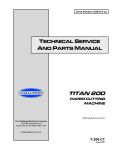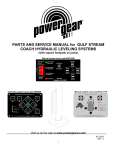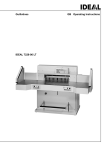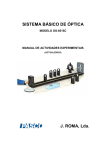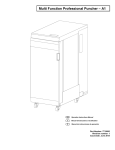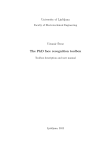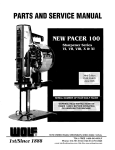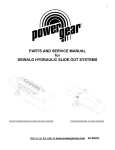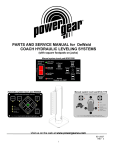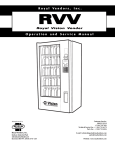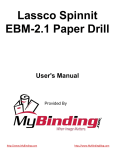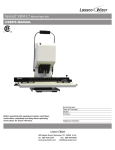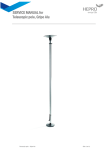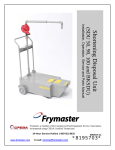Download Supplemental Service Manual
Transcript
TECHNICAL MANUAL TITAN 200 PAPER CUTTER The Challenge Machinery Company 1433 Fulton Avenue Grand Haven, MI 49417-1594 USA Phone: 616-842-8300 Fax: 616-842-6511 ChallengeMachinery.com TM. 200-A MARCH 2000 INTRODUCTION The information contained in this document is intended solely for Challenge trained service technicians. There may be situations that are not covered by this manual. The information contained in this manual is to guide a technician to possible repair solutions. This manual is to be used in conjunction with the TITAN 200 instruction and parts manual P/N F-200 (A). TABLE OF CONTENTS TABLE OF CONTENTS................................................................................................ 2 GENERAL INFORMATION......................................................................................................................... 5 ELECTRICAL SPECIFICATIONS ........................................................................................................... 5 MACHINE DIMENSIONS ........................................................................................................................ 5 MACHINE REVISIONS ................................................................................................................................ 6 TITAN MAIN BOARD REVISIONS ........................................................................................................ 6 CLAMP DAMPENER ASSEMBLY MOUNT REVISION....................................................................... 6 MANUAL MISPRINT ............................................................................................................................... 6 SINGLE CUT BUTTON REVISION......................................................................................................... 6 HYDRAULIC PUMP REVISION.............................................................................................................. 6 MANIFOLD SEAL REVISION................................................................................................................. 6 BACKGAUGE FUSE REVISION ............................................................................................................. 6 FRONT GUARD INTERLOCK SWITCH REVISION ............................................................................. 6 GENERAL HYDRAULIC INFORMATION................................................................................................. 7 HYDRAULIC FLUID CHANGE............................................................................................................... 7 PRESSURE GAGE..................................................................................................................................... 7 OPERATOR SETTING CLAMP PRESSURE .......................................................................................... 7 PRELIMINARY VALVE SETTING ......................................................................................................... 7 VALVE INFORMATION .......................................................................................................................... 7 SOFTWARE REVISIONS ............................................................................................................................. 8 ERROR CODES DESCRIPTIONS .............................................................................................................. 10 ERROR MESSAGES THAT DON’T REQUIRE A FLOW CHART...................................................... 10 ERROR MESSAGES THAT REQUIRE A FLOW CHART ................................................................... 11 SENSOR DATA ABBREVIATIONS AND MEANINGS....................................................................... 12 TITAN 200 TEST & ADJUSTMENT PROCEDURES ............................................................................... 13 TESTING DOWN VALVE COIL MAGNETISM................................................................................... 13 TESTING ANY HYDRAULIC VALVE SPOOL OPERATION ............................................................ 13 SEQUENCE OF ADJUSTING HYDRAULIC PRESSURES ................................................................. 13 TESTING AND ADJUSTING PROX SENSOR ..................................................................................... 13 MANUALLY ACTIVATING THE HYDRAULIC MOTOR.................................................................. 14 TESTING AND REPAIR OF BACKGAUGE BRAKE RESISTOR....................................................... 14 TESTING ENCODER .............................................................................................................................. 14 TESTING ENCODER/BACKGAGE ACCURACY................................................................................ 14 TESTING ENCODER CABLE ................................................................................................................ 15 TESTING INPUTS ON MAIN CIRCUIT BOARD................................................................................. 15 TESTING MAIN BOARD OUTPUT and OUTPUT DEVICES ............................................................. 15 INSTALLATION AND ADJUSTMENTS FOR OF THE KNIFE LATCH ASSEMBLY: ..................... 16 TEST BACKGUAGE ARMATURE........................................................................................................ 16 FRONT GUARD INTERLOCK SWITCH ADJUSTMENT ................................................................... 16 DISASSEMBLY OF SOLENOID COIL CABLE CONNECTOR .......................................................... 17 TESTING AND MANUALLY ACTIVATING KEYBOARD................................................................ 17 EE-2807 MAIN BOARD.............................................................................................................................. 18 BASIC MACHINE SCHEMATIC ............................................................................................................... 19 EE-2807-1..................................................................................................................................................... 20 Basic hydraulic schematic............................................................................................................................. 21 CHAMPION and TITAN CONSOLE PROGRAM MAP ............................................................................ 23 Hydraulic Motor didn’t start ......................................................................................................................... 24 Positioning error ........................................................................................................................................... 25 Clamp/Knife down........................................................................................................................................ 26 2 Clamp stuck down ........................................................................................................................................ 27 Slow backgauge movement to end of table................................................................................................... 28 Hydraulic up failure ...................................................................................................................................... 29 Knife down failure ........................................................................................................................................ 30 Sequence error .............................................................................................................................................. 31 Knife at both limits ....................................................................................................................................... 32 Clamp down failure ...................................................................................................................................... 33 Backgauge failure ......................................................................................................................................... 34 Shorted key error .......................................................................................................................................... 35 “Encoder wires 9 and 10 are reversed” or “Backgauge direction reversed” ................................................ 36 Knife latch failure 1 ...................................................................................................................................... 37 Knife latch failure 0 ...................................................................................................................................... 38 Hydraulic latch error 1 .................................................................................................................................. 39 3 SINGLE OPERATOR Do not operate with more than one person. SHOCK HAZARD Disconnect power before removing cover. Replace cover before operation SHOCK HAZARD Disconnect power before removing cover. Replace cover before operation HAZARD AREA Disconnect power before cleaning, servicing or making adjustments not requiring power. Do not alter safety guards or devices, they are for your protection. Replace all guards, do not operate with any guards removed. 4 GENERAL INFORMATION ELECTRICAL SPECIFICATIONS The cutter requires a 208/230vac 15-amp service. The cutter has a power cord, which requires a NEMA 6-15R or 6-20R receptacle. The proper way to test voltage is from before power up through a complete cycle. The voltage must be tested at the main fuse holders. The meter used must have a reaction time of at least 100ms or a low voltage record function. A low quality meter will not respond fast enough to give a true minimum voltage reading. Low voltage to the cutter will blow the main fuses. When the voltage drops, the 24vac (solenoids) and 5vdc (computer) will have problems. The low limit is 190 vac using the above test. The high limit is 245 vac. The voltage for the power panel can be matched to the measured incoming voltage. Reposition the jumper located in the center of the terminal strip. Do not remove any wires. All Titan 200 s/n 981388 and down are 230vac only. If the voltage drop are 210vac or below during a cut, a buck/boost transformer, p/n K-2834, is required. Note: The buck/boost can also be rewired to buck voltage 250vac down. Call Challenge for rewiring. Always check the serial number tag to determine the proper voltage range. MACHINE DIMENSIONS The Net weight is 755 LB (342kg). The height is 53”(135cm), length is 49” (124cm), and width is 36” (91cm). Removal of the table, front guard and treadle will allow the machine to go through a 31 1/4” (79.4cm) door way. 5 MACHINE REVISIONS TITAN MAIN BOARD REVISIONS The main circuit board, EE-2762, was changed to EE-2762-1. When using an EE-2762-1, the H-10 and H-11 must not be connected. Titan 200 cutters above s/n 971103 use EE-2807, the LCD display is no longer back lit. On EE-2807, the H-10 jumper must be connected and H-11 jumper must not be connected. Both black plastic jumpers are located near the F3 fuse. The EE-2807 can not be used for replacement a EE-2762 and EE-2762-1. The EE-2807-1 is a direct replacement for the EE-2807. The H-10 jumper must be connected and the H11, 12, 13, 14 must not be connected. CLAMP DAMPENER ASSEMBLY MOUNT REVISION The upper mounting stud for the clamp-dampened cylinder has been changed to a three-piece mounting. The first production Titan with the change is s/n 981319, (July-98). The part numbers are H-6938-416 (1/4x20x1"set screw), E-1152-68 (1/4x20x1"hex spacer), H-6918-412 (1/4x20x1½" cap screw). If the stud is broken, it can be removed with an "screw extractor ". Install the set screw so ½" is extended out from the frame. Tighten the spacer onto the setscrew. Slide the cap screw into the top hole of the dampened then tighten screw and damper to the spacer. The fluid in the damper is 100# hydraulic fluid, which is used in the reservoir of the pump. MANUAL MISPRINT Titans s/n 971103 and up main board yellow IN7 input, for hydraulic latch will never light. The Sensor Data input “HYDLAT” will function. Titans s/n 971102 and down the hydraulic latch relay was located on a separate relay board. SINGLE CUT BUTTON REVISION The green light button was changed to a heavier duty non-lighting style. This heavy duty button was used beginning with serial number 981342. Early machines require conversion kit K-2874. HYDRAULIC PUMP REVISION The first machine with the revised motor/pump is s/n 971157 (Dec 97). Replacement pump/motor number is H-220-5. Replacement motor/pump units have a different mounting bolt pattern. It is acceptable to use only two mounting bolts. Parts are not interchangeable from earlier to later units. The manifold and valves are not affected. MANIFOLD SEAL REVISION Hydraulic manifolds stamped with an “-A” in the top corner use a 7/8 ” O- ring. The two O- rings are located between the manifold and the pump. The machines affected are s/n 981271 (Sept-98) to s/n 991570 (Mar-99). BACKGAUGE FUSE REVISION A kit is available to keep the “F1” fuse from blowing. The kit number is K-2908. A 5A (SB) fuse is being added. The first Titan 200 with the new fuse is s/n 991734, August 99. It is located on the revised circuit board (EE-2807-1) and is labeled “FL”. FRONT GUARD INTERLOCK SWITCH REVISION The interlock switch mounted on either side of the front opening was changed by the manufacturer. The first machines affected were built late April 2000. The replacement switch is part number E-2457-6, also six E-1214-65, ¼ “ quick disconnects are needed (per switch). 6 GENERAL HYDRAULIC INFORMATION HYDRAULIC FLUID CHANGE The oil should be changed every 1000 hours or once a year. Use 100 weight (ISO VG 100) hydraulic oil only. An electric hand drill pump can be used to remove the oil from reservoir through the filler hole. The hydraulic pump does have a strainer and magnet. It is recommended as part of the regular oil change that the reservoir be removed to wipe the interior of the tank clean. The O- ring seal may be reused if it is not damaged (p/n is S-1810-37). PRESSURE GAGE The gage supplied with the Titan is filled with clear glycerin. If the gauge liquid turns yellow, hydraulic fluid has leaked into the gauge and it must be replaced. If the rubber top seal leaks, replace the gauge (p/n 8P-629-3). OPERATOR SETTING CLAMP PRESSURE The clamping pressure range is 400 to 800 psi. Turning the clamp pressure reducer cartridge cw increases pressure and ccw decreases pressure. One turn of the adjustment screw equals approximately 75 psi. Don’t adjust below 400 psi. the because clamp and knife will be out of sequence. PRELIMINARY VALVE SETTING The four adjustable cartridge valves in the hydraulic system can be preset manually to an approximate setting. These adjustments should be done only as a last resort. The valves are not interchangeable. Each valve is to be turned in all the way (cw) then turned out (ccw) a specific amount of turns. Main pressure cartridge 4 turns. Knife down sequence 3 turns. Clamp up sequence 1 turn. Clamp pressure reducer (adjustable by the operator) 4 turns (800 psi). Use the hydraulic pressure setting section in the manual for final adjustment. VALVE INFORMATION Listed is general information for testing and checking. VALVE CHALLENGE MANUFACTURES NUMBER NUMBER MAIN SYSTEM HH-304-1 RV1-10-S-0-18/ DOWN VALVE H-200-2 SV1-10-4-0-00 CL. UP SEQ. H-203-6 RV3-10-S-0-36/ CLAMP PRESS H-203-13 PRV1-10-S-0-12/ KN. DN. SEQ.* H-203-7 PSV2-10-S-0-12/ PSV4-10-S-0-12/ ELEC. CL.** H-203-33 EPRV1-5824-14 * KN. DN. SEQ. Used two different valves ** Cartridge comes with coil E-1069-19 SPRING TENSION HEAVY LIGHT MEDIUM MEDIUM MEDIUM MEDIUM LIGHT INNER SPOOL MOVEMENT ¼” (6MM) 1/8” (3MM) ¼” (6MM) ¼” (6MM) 1/8” (3MM) 1/8” (3MM) 3/16” (5MM) 7 SOFTWARE REVISIONS Titan 200 with front guard using EE-2762 circuit board and EE-1766-41 software. 1.0 1.1 1.2 1.3 1.4 1.5 1.6 1.7 Original software. Increased knife latch timing. False Camp Plate limit was 1.750; changed it to 1.875. This revision contains all of the languages. In fraction mode corrected positioning problem. Increased timing between scr and brake turning on an off. This is performed at the beginning of each zero cross. Enables the Preset interrupt during the zero-cross. Allowed maintenance mode access during preset screen. Changed send routine for better positioning accuracy. Added noise protection to prevent erroneous backgauge control touch pad movement. This error causes the machine to show actual backgauge position instead of the "sent to" value. Allow accuracy adjust to be set in mm. Fixed a backgauge creep problem that would occur if the foot pedal was pressed during a send. Note: This is the highest possible revision software the for EE-2762 circuit board. New Board, EE-2807 Starting at s/n 971102 1.9 2.0 2.1 2.2 2.3 2.4 2.5 2.6 2.7 2.8 2.9 Added a delay in the backgauge routine to prevent fuses from being blown in the backgauge circuit when using the slide pot in the center or bottom edge. A) Added Challenge logo to sleep screen. B) Added electric clamp option in the “diagnostic” menu. C) Immediately position to 5” after preset. Changed reverse limit from 20.050 to 20.030 to prevent bumping in the back. A) Electronic clamp pressures range adjustable in the DIAGNOSTIC menu. B) REPOSITIONING is added as an option in the parameters menu. This allows the machine to reposition automatically from a sent position if the back gauge moves back .005” or more. C) When entering data in a job, if a math function key is pressed, the operation assumes the previous data, not the backgauge position. Forced PUSHOUT if the forward movement is < .005”. Allow ELECTRIC CLAMP option to be on. If the backgauge is moving at a high speed, the brake is applied near the front and back to prevent bumping. A) Added auto memory initialization for new boards. B) Added memory test to initialization routine. C) Correct translation errors. A) Improved positioning time by shortening the slow down distances and making the slow down distance self-adjusting between .2” and .75”. B) Added input status to the end of several error messages. Knife Latch Failure 1 = Latch disengaged when it should be engaged Knife Latch Failure 0 = Latch engaged when it should be disengaged Hyd Latch failure 1 = Latch Relay is off When it should be on. Hyd Latch failure 0 = Latch Relay is on when it should be off. A) Adjust for new 1/8 hp back gauge motor B) Service message reads “Lubricate Machine” C) Lubricate alarm frequency twice knife alarm count D) Attempt to reduce F1 blowing computer responds quicker to the backgauge movement Commands Improved electronic clamp pressure routine to reducing changing “CP” number. 8 Titan 200 with cut buttons (N.C.) using EE-2807 circuit board and EE-1766-42 software The revision descriptions for 2.0 and on is the same as EE-1766-41 Titan 200 with cut buttons (N.O.) using EE-2807 circuit board and EE-1766-50 software 2.3 Original software. 2.5 If the backgauge is moving at a high speed, the brake is applied near the front and back to prevent bumping. 2.6 A) Added auto memory initialization for new boards. B) Added memory test to initialization routine. C) Correct translation errors. 2.7 A) Improved positioning time by shortening the slow down distances and making the slow down distance self-adjusting between .2” and .75”. B) Added input status to the end of several error messages. Knife Latch Failure 1 = Latch disengaged when it should be engaged Knife Latch Failure 0 = Latch engaged when it should be disengaged Hyd Latch failure 1 = Latch Relay is off When it should be on. Hyd Latch failure 0 = Latch Relay is on when it should be off. 9 ERROR CODES DESCRIPTIONS ERROR MESSAGES THAT DON’T REQUIRE A FLOW CHART ERROR EXPLANATION PROCEDURE Result is Negative Math operation result was negative Press Clear key Data out of Range Send position beyond forward or reverse limits Press Clear key Send Canceled Back gauge in motion and a console key was pressed Press Clear key then Send key to complete movement Number Outside Limit Send position beyond forward or reverse Limits Press Clear key Back gauge at Limit Back gauge position at either end of table Move back gauge in opposite direction Memory Locked Tried to change a locked channel Press Clear key Next Channel Locked Linked channel locked Press Clear key. Move locked channel to another. location Sharpen Knife Operator sets knife count for sharpening Clear message: Enter Maintenance, Enter Parameters, Enter Knife count Enter clear count. Press exit 4 times Change knife count Enter Knife Count Enter Knife Alarm. Enter number of cycles Press exit 4 times Lubricate Machine The relubrication message has been activated Clear message: Enter Maintenance Enter Parameters, Enter Knife count Enter clear lube. Press exit 4 times. Checksum Error Memory Failed Defective EPROM chip. Memory failured Replace chip Replace main board . Hyd latch error 0 Board mounted relay failed to turn off Sensor data, “hydlat” didn’t change from 0 to 1 Occurs when pump motor turns off Replace main board EE-2807-1 10 ERRORS (NO MESSAGE) THAT REQUIRE A FLOW CHART ERROR EXPLANATION PROCEDURE Clamp stuck down Upward movement of spring return clamp Did not overcome mechanical bind. See flow chart page 27 Slow backgauge movement to end of table Main board is sensing the preset is always activated. See flow chart page 28 Hydraulic motor didn’t start Motor didn’t start at the beginning of a cut See flow chart page 24 A continious beeping Press CLEAR to stop alarm See Positioning Error. ERROR MESSAGES THAT REQUIRE A FLOW CHART ERROR EXPLANATION TEST PROCEDURE Hyd up failure Clamp failed to return up after 4 sec. See flow chart page 29 Knife down failure Knife failed to go down after 4 sec. See flow chart page 30 Knife up failure See Sequence Error or Knife at both limits Sequence error Knife came down before clamp or Clamp came up before knife. Clamp up prox made while knife up prox unmade. See flow chart page 31 Knife at both limits Knife up or knife down proximity sensor not switching or switching at the wrong time See flow chart page 32 Positioning error Back gauge missed programmed position by .005”. Back gauge accuracy off by .010” when wand goes through preset sensor, See flow chart page 25 Clamp/Knife down When in a program or send mode (Not manual backgauge mode) knife or clamp not up See flow chart page 26 Clamp down failure Clamp did not come down at the start of a cycle See flow chart page 33 Backgauge failure Backgauge did not move after presetting See flow chart page 34 Shorted key error Any key (except backgauge slide)held on for longer than 90 seconds See flow chart page 35 Encoder wires 9 and 10 are reversed or Backgage direction Reversed Encoder wire pulse wire are backwards or backgage power wires are backwards. Typically this happens only on a table out installation. See flow chart page 36 11 Knife latch failure 1 Prox sensor on when should be off. The pin should be in the disengaged position i.e. pulled out from under knife bar. See flow chart page 37 Knife latch failure 0 Prox sensor off when should be on. The pin should be in the engaged position i.e. pushed under knife bar. See flow chart page 38 Hyd latch error 1 Board mounted relay failed to turn on Motor will not start Sensor data, “hydlat” didn’t change from 1 to 0 See flow chart page 39 SENSOR DATA ABBREVIATIONS AND MEANINGS The knife and clamp are at top of stroke with the hydraulic motor off and line light on. INPUTS/OUTPUTS RHSAFE (in) LHSAFE (in) KNFLAT (in) KYDLAT (out) KNFDWN (in) PRESET (in) CUTSOL (out) UNLOAD (out) KNLATSOL (out) CLAMPUP (in) HYDUP (in) KNFUP (in) CUTBTN (in) N.C. HYDMOT (out) N.C. LTLINE (out) CBTNLIT (out) IDLE 0 0 1 1 1 1 0 0 0 1 1 1 0 0 0 0 1 0 DESCRIPTION R. H. safety switch or cut button L.H. safety switch or cut button Knife latch proximity sensor hydraulic latch relay Knife down proximity sensor Preset sensor Cut Down valve Not used Knife latch solenoid Clamp up proximity Clamp cylinder up proximity Knife up proximity Single cut button not used hydraulic motor relay Not used Line/table light Not used LOCATION Inside right font cover Inside left front cover Left side of cutter opening Main board Lower right corner of knife bar Under left side of table Solenoid on left side of hyd. manifold Left side of cutter opening Top right corner of clamp (rear view) Bottom of clamp cylinder Top left corner of knife bar Green button on console Right of main board Two light bulbs above knife bar 12 TITAN 200 TEST & ADJUSTMENT PROCEDURES TESTING DOWN VALVE COIL MAGNETISM 1. Remove the ¾" nut holding the coil to the valve. 2. Slide the coil away from the base of the valve ¼". 3. The coil should move easily on the valve stem. 4. Make a cut. 5. If there is voltage and the coil is good, magnetism will move it back the ¼" to the base of the valve. If a screw driver blade is placed inside the center of the coil then cycle the cutter. If magnetism is felt the coil, cable and main board is good tested. TESTING ANY HYDRAULIC VALVE SPOOL OPERATION 1. Remove the valve from the manifold. There isn’t trapped hydraulic pressure, some fluid will flow out. Always use a 1” box end wrench or deep well socket only on the hex on the valve. Never use an adjustable wrench or pliers to remove or install a valve. 2. Use a small rod to push in on the end of the valve that was in the manifold. The spool inside the valve must move smoothly in both directions. Each valve type has a different spring tension and some do not have springs at all. On adjustable valves, the spring tension can be lessened to help in testing spool movement. Loosen the jam nut then turn the allen screw CCW to reduce spring pressure. See General Hydraulic Information, ie Valve information for spring tension. 3. Check for damaged black “O” rings or white split Teflon spacers. 4. Check the manifold cavity for loose particles 5. Reinstall valve. It does not require excessive force to retighten the valve. Do not tighten over 40 FT LB of torque. 6. Typically, a valve that cannot adjust its pressure range is defective. SEQUENCE OF ADJUSTING HYDRAULIC PRESSURES Turn adjuster clockwise to increase pressure, counter clock wise to reduce pressure. Reference F. 200 parts manual hydraulic schematic page for cartridge location. 1. Turn the clamp reducer valve (item 4), located on front face of blue manifold block, CW all the way. 2. Read main system pressure when clamp and knife are at the bottom of stroke. Adjust valve (item 11) on front of black pump to 1400psi. 3. Read knife down sequence pressure when clamp is at the table and the knife is moving down. Adjust front valve (item3) located on right face of manifold block to 900psi. 4. Read clamp up sequence when the knife is at top of stroke and the clamp is moving up. Adjust rear valve (item 1) located on right face of manifold block to 600psi. 5. Adjust clamp reducer valve, item 4, to a range of 400 to 800psi when clamp and knife are at the bottom of stroke. TESTING AND ADJUSTING PROX SENSOR 1. Access the “SENSOR DATA “ menu in the console. The zero and ones to the right of the abbreviations will indicate changed status as the prox is activated. 2. Place a thin metal strip in front of sensor. The target area has four red squares in a block pattern. When the strip is placed in front of the sensor the red LED should turn on and the sensor data indicator should change. 3. The distance from the rectangular prox sensor to a moving part is typically .01” to .06”. The distance from the round prox sensor to a moving part is typically .01” to .125”. 13 MANUALLY ACTIVATING THE HYDRAULIC MOTOR Pressing the manual pin on the motor relay will activate the motor. This will raise the clamp and knife to the full up position. The relay is located on the right side center of the electrical panel. Do not push the relay for longer than 3 seconds, the main fuses may blow! 1. S/N 971102 and down the relay is 1.5” x 3” and brown/black with a small button on the long side. 2. S./N 971103 and up the relay is 3” x 3” and black in color. Press the top white plastic piece down. TESTING AND REPAIR OF BACKGAUGE BRAKE RESISTOR 1. Resistor is white, 2” long by 3/8” square (may be two side by side), located on the right end of main board EE-2807-1. The resistor is next to the BRK, SCR, and DIR red LED’s 2. Measure resistance from one lead to the other. A reading of 5 ohms means the resistor is good. A reading of infinity means the resistor is open and must be replaced. 3. A pair of 10 ohm, 10watt resistors can be purchased from Radio Shack, # 271-132. 4. Cut the defective resistor leads at the end of the resistor. This will leave a lead from the board to solder too. 5. Apply silicon sealant to the bottom of the new resistor 6. Lay the new resistors side by side (with silicone sealant in between) then wrap one lead around the other lead and solder. 7. Place new resistor on the board then cut the leads to overlap the leads on the board by 3/8”. 8. Solder resistor leads to board leads. TESTING ENCODER Measure voltages on the screw heads of the EE-2807-1 header. If the voltages are correct, the EE-2807 is defective. The test gives a general condition of the encoder as it impossible to count all encoder pulses. If the voltages are not correct, see “TESTING CABLE”. If cable is good, the encoder is defective. Turn motor pulley very, very slowly when testing A and B pulse. Cable connector 18 (black) 20 (red) 17 (white) 19 (green) Header H2-4 H2-3 H2-1 H2-2 Function common “+” voltage “A” pulses “B” pulses Voltage common 5 vdc, power toggles 5 & 0 vdc toggles 5 & 0 vdc TESTING ENCODER/BACKGAGE ACCURACY This test is preformed when the accuracy alarm is activated or there is a question of backgage point to point accuracy. 1. Remove the backgauge pulley cover. 2. Turn off the REPOSITIONING option in the parameter menu. 3. Move the backgage to rear of the table. Manually turn the leadscrew pulley back til the backgage stops. Write down the dimension shown on the display. 4. Move the backgage only with the manual slide control to at least 6 different positions, never coming forward of 7 ” (178mm). 5. Repeat step 3. The two numbers should match within (+ or -) .002. 6. If the numbers match the accuray problem is in the loading of the paper, backgage squaring or accuracy adjutment. If the numbers do not match the encoder, encoder cable or main board may be defective. 14 TESTING ENCODER CABLE 1. Unplug the cable connector at encoder. Measure voltages at the cable connector. 2. If voltages are correct, cable (E-2534-1) and main board (EE-2807) are good. If voltages are not correct, go to step 3. 3. With the cable connector still unpluggged at encoder, measure the voltage at the header screws. If voltage is correct the main board is good and the cable is defective. Cable connector 18 (black) 20 (red) 17 (white) 19 (green) Header H2-4 H2-3 H2-1 H2-2 Function common “+” voltage “A” pulses “B” pulses Voltage common 5 vdc 5 vdc 5 vdc REPLACEMENT EE-2807 & EE-2807-1 CIRCUIT BOARDS 1. Transfer all fuses from the original board to the new board. The FL fuse (EE-2807-1 only) will not have to be transferred. Fuse clips may have to be tightened (squeezed togethre) before reinstalling a fuse. 2. Transfer the EPROM from original board to the new board. Tip: Before removing old EPROM note position of locating notch on the chip. 3. The H-10 link must be connected, otherwise “Hydraulic Latch Error” will be displayed. The H-11 link must not be connected, otherwise the display and keyboard will not work. On EE-2807-1 links H-12, H-13, H-14 should not be made. 4. Test and adjust the back gauge accuracy. TESTING INPUTS ON MAIN CIRCUIT BOARD Inputs on the main board, EE-2807-1, can be manually activated. If the LED does not light nor the sensor data input change, the main board EE-2807 is defective. The sensor data menus are based on the the power on, knife/clamp in the up position and the hydraulic motor off. 1. Remove wire for the input to be tested from green header. 2. Touch one end of 12” insulated jumper wire to any 64 wire terminal. 3. Touch the other end of the jumper wire to the screw head where the input wire was attached. 4. If yellow LED lights, then the sensor or wiring is defective. If the yellow LED or the sensor data input doesn’t change the main board, EE-2807, is defective. TESTING MAIN BOARD OUTPUT and OUTPUT DEVICES Outputs can be manually activated, except for the backgauge motor. The red output LED’s only indicates computer commands, not actual operation of the output device. Connect an insulated jumper wire from the 24vac supply (wire #33) then touch the other end of the wire to the to the screw head where output device wire is attached. The desired output device should turn on i.e., solenoid, relay or light. (Note: An error may be displayed). If the device turns on manually, the main board, EE-2807 is defective. If the device does not turn on, the device, wiring or F2, F3 is defective. Output voltage can be measured. Check the voltage between at the main board output wire (?) and wire #35 when the machine is activated. NOTE: An unloaded output will measure a static voltage. The voltage will disappear or change when a load is applied. 15 TESTING AND LEVELING THE CLAMP 1. Remove the cut stick, false plate clamp if installed. Clean the bottom of the clamp. 2. Place a 2 1” x 22” strips of paper lengthwise from under the clamp (right and left), to the front edge of the table. 3. Close guard, if equipped, and make a cut. 4. When the clamp is at the table and the knife is swinging down, pull on the paper strips. 5. If the clamp is parallel, both strips will be held. If one of the strips is loose the clamp will have to be adjusted. 6. The adjustment is made by turning the nuts on the top and bottom of the pull clamp pull down rods. Adjust the side that does not hold the strip. Make only 1/8-turn adjustments. Loosen the upper nut. Tighten the lower nut to lower the high side. 7. Repeat steps 1 through 7 until both strips are held. INSTALLATION AND ADJUSTMENTS FOR OF THE KNIFE LATCH ASSEMBLY: 1. The retracted position of the knife latch pin is adjusted before installation. The end of the pin should be flush with the face of the block that it slides through (the plastic screw head does not matter). Check the position of the pin by pushing in the solenoid plunger (not the lever) to bottom of its travel. a). Loosen the mounting screws of the solenoid. b). Push in the solenoid plunger to bottom of its travel. c). On the 41120-1 version slide the solenoid with plunger pushed in so the knife latch pin end is flush with the block. On the 41120-3 version slide the solenoid with plunger pushed in so the plastic screw on end of the latch pin is flush with the block. d). Retighten the solenoid mounting screws. 2. The latch assembly mounting plate should be visually parallel to the knife bar. 3. The top of the knife latch pin should be 1/64” (0.3mm) to 1/32” (0.5mm) below the knife bar. This clearance is set only when the knife is in the full up position (see manually section “Activating the hydraulic motor”). The latch plate mounting screws will have to be loosened slightly. The height adjusting screw is located at the bottom of the plate. Turn the screw CW to raise and CCW to lower the plate then tighten the jam nut. Tighten the mounting plate screws. INSTALLATION TIP: The top cover of the cutter should be tilted forward and the left front table side guide should be removed for easier access. Table side guide mounting screws can be removed through the two side left access hole covers using the knife bolt wrench. 4. The proximity sensor should be 1/64” (0.5mm) to 1/32” (1.5mm) from the solenoid lever arm. The sensor has a red four-point target for activation. TEST BACKGUAGE ARMATURE 1. Turn power off. (Procedure measuring backgauge motor for opens and shorts) 2. Unplug the H1connector on the main board and remove motor cover. Measure the resistance between wire 45 and 46. Rotate motor pulley in small increments (one complete turn) while reading the resistance at each incremental stop. The nominal resistance should be 12 ohms. Values above 12 indicate open and values below indicate a short in the armature. 3. Unplug the H1connector on the main board. Measure the resistance between wire 45 and 46 to the unpainted part of the motor case. A reading of infinity (open) is correct. A reading less than infinity indicates a short. FRONT GUARD INTERLOCK SWITCH ADJUSTMENT 1. Remove the interlock switch bracket assembly from the top cover. 2. Bend the strap, near the mounting screws, so it is parallel to the face of the interlock switch and has .015” clearance to the tip of the plunger. 3. Reinstall the bracket on the top cover. Open the front guard then adjust the interlock switch bracket assembly so the strap is flat against the cover but not depressing the plunger. 16 DISASSEMBLY OF SOLENOID COIL CABLE CONNECTOR 1. Remove screw completely from the center of square connector then remove connector from coil. 2. Unscrew cable strain relief nut. 3. Turn connector upside down. Place a small screwdriver in the narrow slot in one of the corners of the red center piece then pry it out. The cable will need to be pushed in. 4. Voltage can then be measured between the wires. TESTING THE DISPLAY CONTRAST The LCD display uses 19 Volts DC for the contrast adjustment. The voltage is produced on the main circuit board, EE-2807. The contrast voltage on the main board can be measured from header H2 pin 7, to the non-line end (anode) of the diode located next to the H8 header. Use the left drawing below for (d) diode location. EE-2807-1 EE-2764 H8 Header The level of contrast is adjusted by a potentiometer located on the back of the console. The voltage is measured on the keyboard interface board located under the console cover. Use the above right drawing for reference. Use the left end of the resistor (shown with a "C") as the common. The voltage at leg 3 on the potentiometer should read -19vdc. The voltage at "2" on the potentiometer will have a range of 9vdc to 19vdc. Nominal operational voltage is approximately 12vdc. Conclusions: No voltage between diode and H7-2, defective EE-2807. No voltage between "C" and # 3, defective ribbon cable EE-2855-2. No voltage between "C" and # 2, defective EE-2764. All voltages good, defective LCD display, defective EE-2758-1. TESTING AND MANUALLY ACTIVATING KEYBOARD 1. Remove the metal cover behind the console. 2. Disconnect blue tipped ribbon cable from interface board. 3. Turn power on. 4. Use a jumper wire shorting the exposed pins to manually activate a key function. Use the diagram and key list below. 5. If the console shows activity by manually jumping the pins, the keyboard is defective, 43002. KEY PIN KEY PIN Backgauge Slide Key Clear #1 #3 #5 #6 #7 #9 5 to 11 9 to 13 7 to 13 8 to 12 7 to 12 9 to 11 7 to 11 Send #2 #4 5 to 13 8 to 13 9 to 12 Pin 1 to 3 Pin 1 to 2 Pin 2 to 3 #8 #0 8 to 11 8 to 10 Interface board 1K ohms fixed 1 K ohms variable* 1 K ohms variable* *when pressing guide 17 EE-2807 MAIN BOARD 18 BASIC MACHINE SCHEMATIC 19 EE-2807-1 20 Basic hydraulic schematic 21 CHAMPION and TITAN CONSOLE PROGRAM MAP SEND SCREEN REPEAT (xg only) JOB MAINTENANCE COPY LOCK ERASE ORIGIN/STEP JOB NUMBER LANGUAGE KNIFE ADJUST MANUAL PROGRAMING UP/DOWN English,French, German, Spanish, Portuguese LABEL (xg only) DIVISION (XG only) PARAMETERS MACHINE CNT FALSE CLAMP PUSHOUT ACCURACY ADJ ON/OFF DIAGNOSTICS ON/OFF REPOSITION ADJUST CLAMP (Titan 200 optional) ERROR CODES SENSOR DATA ON/OFF SET MAXIMUM KNIFE CNT TIMEOUT CLEAR MEMORY yes/no SET MINIMUM KNIFE ALARM CLEAR COUNT SET CLEAR LUBE 5,10,20,30 MINUTES ELECTRIC CLAMP, on/off (Titan only) CUT&REC (xg only) Hydraulic Motor didn’t start Are F2, F6 fuses good? Replace defective fuse and check tighteness of holder. No Yes Does the red output led 1 lite? Does the cutter have a front plexiglass guard ? No In the sensor data menu does RHSAFE and LHSAFE change to "1" when each respective cut button is pressed ? No Yes Yes Yes No Is there 24vac between wire #41 and #35 at the main board? No Replace main board EE-2807-1. If wire #64, #54 ,#53 connections are good, replace cut button switches. Yes Is there 24 vac between wire #39 and #35? No Test cut button/interlock switches contacts and wires #39, #40, #41. Yes In the sensor data menu does RHSAFE and LHSAFE change to "1" when the front guard is lowered ? No Replace main board EE-2807-1. If wire 64, 54 ,53 connections are good See hood adjutment procedure. Yes Does the pump relay turn on? No Replace relay, see manual In the sensor data menu does CUTBTN change to a "1" when single cut button is pushed ? Yes Is there 230vac between wires 31 and 32? Yes No No If wire connections #64and #57 are good, replace single cut button, E-2641-2. Yes Replace relay, see manaul. Replace EE-2807-1. Replace motor, see manual. 24 Positioning error Test each of the choices Test another choice. Does the backgauge move smoothly when turning the rear pulley? Yes Yes Are the motor brushes binding in the holder ? Does the backgage stop with no drift after the slide guide is pressed for full speed then released ? No Remove the bind. Test another choice. Does the brake resistor measure 5 ohms? Yes Test another choice. No No Readjust. Yes Are the gib screws adjusted too tight? Yes Rplace EE-2807-1. No No Rplace EE-2807-1 or repair, see Adjustment Procedure section. Clean without chemicals . Yes Is the preset sensor dirty? No No Lubricate. Is the backgauge guide rail lubricated? Yes Is there end play in the leadscrew ? No Test another choice. Yes Test another choice. Check for loose or misaligned parts such as pillow blocks. Adjust thrust washers for zero end play. No Is the preset wand loose or not moving through the sensor? Yes The wand must travel through the sensor center and go as deep as possible without touching. The wand and sensor must not be loose. 25 Clamp/Knife down Press "clear" then press send to remove error Check other options In the sensor data menu is KNFUP a 1 when the knife bar is at the top stroke ? Yes No Check other options. Yes In the sensor data menu is HYDUP a 1 when the clamp cylinder is at the top of stroke? No Replace main board EE-2807-1. Yes Replace main board EE-2807-1. Yes Is yellow input led in 3 lit? No Yes Yes Check other options No Is the yellow input LED 4 lit? No If wire #60 connections are good replace proximity sensor, E-2204-1 In the sensor data menu is CLAMPUP a 1 when the clamp is at the top of stroke? Is the Knife up proximity red LED lit ? If wire #61 connections Yes are good replace proximity sensor, E-2204-1 Is the red hyd up proximity LED lit ? No Is the yellow input LED 2 lit? Yes Replace main board EE-2807-1. No Is the clamp up proximity red LED lit ? Yes If wire #62 connections are good, replace proximity sensor, E-2204-1 No No If wire #63, #64 are good replace proximity sensor, E-2204-1 Yes Is the actuator within .03", 1mm of the proximity sensor? Is the proximity sensor within .03", 1mm of the knife bar ? Yes No Is the hyd up proximity within .03", 1mm of the round plate? No Yes If wire #63, #64 connections are good replace proximity sensor, E-2204-1 No Adjust Adjust If wire#63, #64 connections are good, replace proximity sensor, E-2204-1 Adjust 26 Clamp stuck down Free clamp by prying up on the side of the clamp that thats not holding paper. Place your foot on the manual clamp bar to prevent the clamp from bouncing up. Suggestions to prevent this from happening again. For following items refer to the adjustment procedure section. Lower clamp pressure 100 to 200 psi. Parallel clamp to table. Grease clamp guides. Check for broken clamp return spring. Tell operator to cut narrowl stock in center of clamp. Slow backgauge movement to end of table No Did back gauge move to the rear after pressing "CLEAR" ? Yes The wand must travel through sensor center and go as deep as possble without touching. The wand and sensor must not be loose. Is the preset sensor broken or loose? Yes Replace preset EE-1688-1. No Are wires #12, #18, #20 loose at the preset or the main board ? Yes Repair connection. No Does the voltage change from 0vdc to 5vdc between wire #12 and #18 when blocking the preset sensor with chip board ? No Replace preset EE-1688-1. Yes Replace main board EE-2807-1. 28 Hydraulic up failure Yes In the sensor data menu is the HYDUP a 1? Yes Is the clamp cylinder shaft at the top of stroke (5/8" or 16mm between the round actuator disc and the bottom of the cylinder)? No Replace main board EE-2807-1. No Is the yellow input LED 3 lit ? Yes Replace main board EE-2807-1 No Replace valve H-203-6. No Will adjusting the clamp up sequence valve CCW allow the clamp to go up? Yes Is the Hyd up proximity red LED lit? Yes If wire #61 connections are good replace the proximity sensor, E-2204-1 Remove and test valve per adjustment procedure section. No Is the actuator disc within .03",1mm of the proximity sensor? Yes If wires #63, #64 connections are good replace proximity sensor, E-2204-1 No Adjust sensor or actuator disc. 29 Knife down failure Yes Did the knife move No to bottom of stroke? In the sensor data menu did the KNDWN change to a 0 when the knife was at the bottom of stroke ? Yes Replace main board EE-2807-1 No Is the main system pressure set to 1400 psi? No Yes Does the yellow input LED 9 turn off when the knife bar is at the bottom of stroke? Yes Replace EE-2807-1 Is the knife down sequence set to 900psi? No No Yes Reset to 900psi. Check for broken cylinder bracket, dry knife guides, mechanical binds. Did the knife bar move below the knife down proximity sensor at the bottom of stroke? Can the main pressure be reset? Yes No Yes No Check for mechanical bind in the knife bar and knife cylinder. Replace the proximity sensor, E-2204-1 Adjust. See Adjustment Procedures section. Remove valve and test. See Adjustment Procedures section 30 Sequence error Repower machine. If error is repeated continue on. Does the knife bar start down before the clamp? No See other choice. See other choice. No Yes Does the clamp return to the top of stroke before the knife bar? Yes Adjust clamp reducer valve CW to increase pressure. Yes Is the knife down sequence pressure set below 900psi? No Is the clamp pressure set below 400psi? No Yes Check for mechanical bind or too high paper lift. No Replace clamp up sequence valve H-203-6 Can the clamp up sequence pressure be set to 600psi? See adjustment procedure Yes Can the pressure be raised to 900psi? See adjust procedure. No Replaceknife down sequence valve, H-203-7. Check for knife bind. Yes Adjust 31 Knife at both limits No Did the yellow LED input 9 turn off ? Yes In the sensor data menu did KNDWN change to a 0 when the knife bar was at the bottom of stroke? Replace main board EE-2807-1 Yes Replace main board, EE-2807-1 In the sensor data menu is the KNFUP a 1 when the knife is at the bottom of stroke ? No No Yes Replace proximity sensor, E-2204-1 No Is the yellow LED input 4 lit ? Yes Does the knife down proximity red LED turn off ? Yes If wire #56 connections are good replace proximity sensor, E-2204-1 No If wire #60 connections are good replace proximity sensor. E-2204-1 No Is the knife up proximity red LED lit ? Yes Is the knife down proximity sensor within .03", 1mm of the knife bar? No Yes If wre #63, #64 connections are good replace the proximity, E-2204-1 Check for knife bar binds. Adjust 32 Clamp down failure Did the pump turn on? No See Hydraulic Motor Didn't Start flow chart Yes Did the red LED output 2 lite and CUTSOL change to a 1 in the sensor data menu ? No Replace main board, EE-2807-1 Yes Is there 24vac between wires #42 and #35 at the main board? No Replace main board, EE-2807-1 Yes Is there 24vac between wires #44 and #35 at the gray terminal strip? No Check cut button/interlock switches, wire connections and see hood adjustment procedure section. Yes Is there 24vac between wires #44 and #35 at the down coil connector? No If wire #44 and #35 connections are good replace cable,EE-2769 Yes Does the coil have magnetism? See coil magntism adjustment procedure. No Replace coil, E-1069-17. Yes After reinstalling the valve, the cutter works, there is contamination in the fluid. Replace fluid and clean tank, strainer, magnet. Yes Does the removed down valve test good? See hyd valve adjustment procedures No Replace valve, H-203-6 33 Backgauge failure Is the F1or FL fuse blown? Yes Does the fuse F1 or FL blow after replacement? No No Check and tighten fuse holder. Yes Test main board, encoder and encoder cable per Adjust procedure section. No Does the backgage surge then stop? Yes Does the back gage bind when the rear pulley is turned manually? Yes Locate and remove mechanical bind. No Replace EE-2807 board. When the backgauge is told to move, Does the SCR led turn on and the BRK led turn off? No Yes Does the motor armature have a electrical short, See Adjustment procedure Yes Replace motor. See manual for part number No Replace EE-2807 board. No Is there any dc voltage between wire #45 and# 46? Replace EE-2807-1 Yes Check for open motor armature, broken wire, stuck motor brush, See adjustment procedure. 34 Shorted key error Does the console have a single beep on power up? Yes Does the console sound a single No beep after the blue keyboard cable is unplugged and plugged in again? No Nornal operation. After the clear is pressed does the backgauge move to the fwd or rev limit? No Yes Yes Replace EE-2807-1. Replace the key board, 43002. Disconnect keyboard cable just after the clear key is pressed. replace the EE-2807-1. Yes Does the backgauge move as before? No Replace the key board, 43002 . 35 “Encoder wires 9 and 10 are reversed” or “Backgauge direction reversed” Typically errors occur after a table out installation Yes Is wire #17 connected to H2-1 and wire #19 connected to H2-2 on main board? No Check other choice. Wire correctly. Is black motor wire connected to blue cable wire and red motor wire connected to brown cable wire? No Yes Check other choice. Wire correctly 36 Knife latch failure 1 Did pump turn on ? See Hydraulic Motor Didn't Start flow chart. No Yes Yes Does the pin disengage from the knife bar? Yes When the knife bar is at top of stroke, is there .03", 1mm, clearance from pin to knife bar? See adjustment proceduce No Adjust bracket. In the sensor data menu does the KNFLAT change to a 0 during a stroke? No Replace main board, EE-280-17 Yes No No Replace EE-2807-1 Is red led output 6 turning on? Yes Replace solenoid, E-974-2. During a cut is there 24vac at solenoid wires #35, #47 ? Yes No Does the yellow input LED 6 turn off? Yes Replace the main board EE-2807-1 No Replace main board, EE-2807-1. No During a cut is there 24 vac at main board wires #35, #47 ? Yes If wire #59 connections are good replace proximity sensor, E-2204-1 Check for loose or broken wire #35, #47. 37 Knife latch failure 0 Yes Replace main board,EE-2807-1 Yes In the sensor data menu is the KNFLAT a1? Is the knife latch pin under the knife bar when the knife bar is at the top of stroke? No Replace spring, 41117 Yes No No Replace main board EE-2807-1 Yes Is the yellow input LED 6 lit ? No If wire #59 connections are good, replace the proximity sensor, E-2204-1 Yes Is the knife latch proximity red LED lit ? Is the return spring broken? Check for binds No Is the solenoid engerized? Yes Replace main board, EE-2807-1 No If wire #63, #64 connections are good, replace proximity sensor, E-2204-1 Yes Is the latch lever within .03, 1mm of the proximity sensor ? No See knife latch adjustment procedures 38 Hydraulic latch error 1 Did the pump turn on? No See Hydraulic Motor Didn't start flow chart Yes Does wire #39 have a good connection at main board header and the gray terminal strip? No Repair Yes Does wire #35 have a good connection at main board H7-4 header and at the gray terminal strip? No Repair Yes Does jumper H-10 on the main board have a good connection? No Repair Yes Replace main circuit board, EE-2807-1 39 40








































